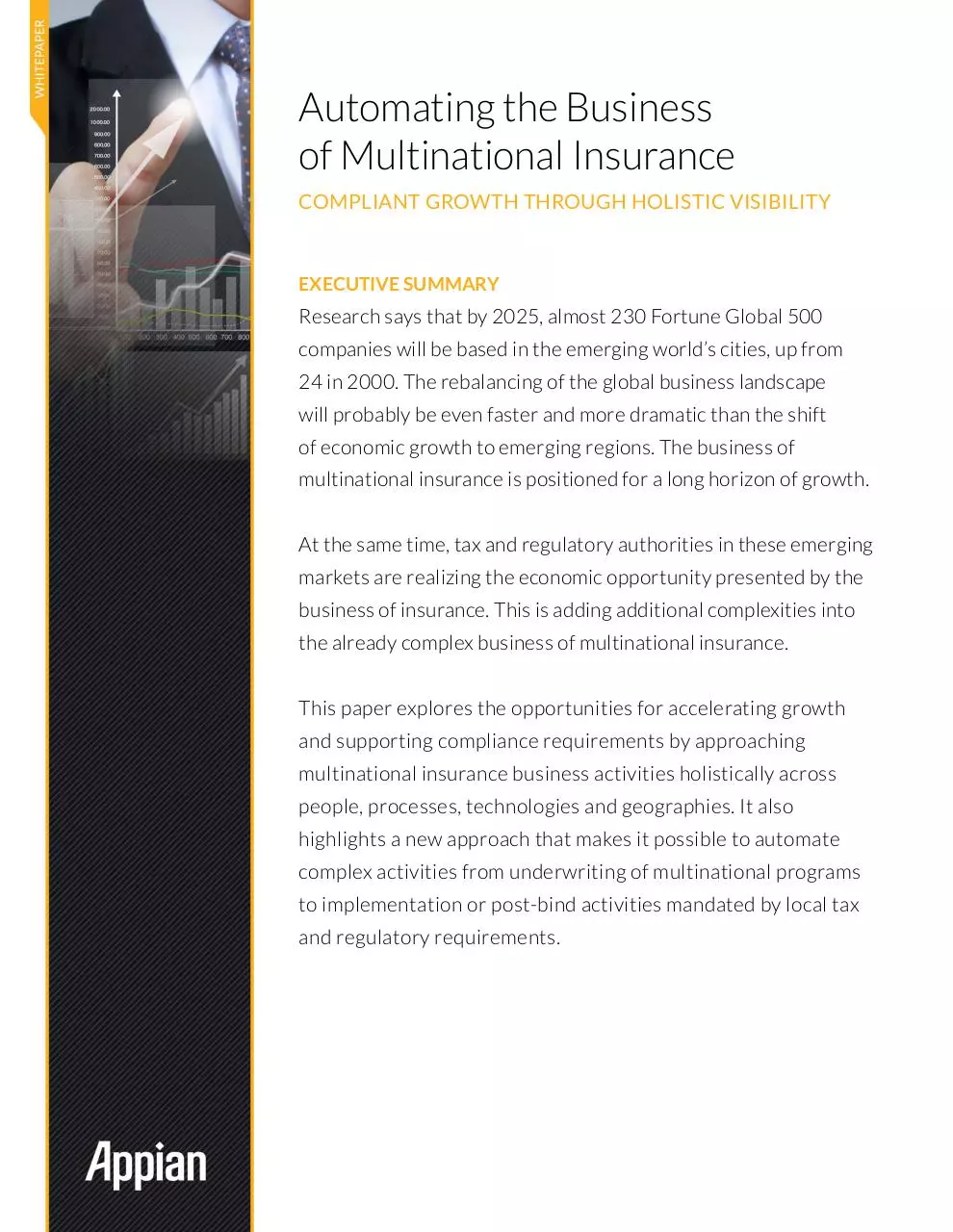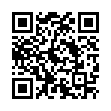453571 Automating the Business of Multinational Insurance (PDF)
File information
This PDF 1.7 document has been generated by Adobe InDesign CC 2014 (Macintosh) / Adobe PDF Library 11.0, and has been sent on pdf-archive.com on 13/01/2016 at 08:16, from IP address 76.21.x.x.
The current document download page has been viewed 495 times.
File size: 612.78 KB (5 pages).
Privacy: public file





File preview
Automating the Business
of Multinational Insurance
COMPLIANT GROWTH THROUGH HOLISTIC VISIBILITY
EXECUTIVE SUMMARY
Research says that by 2025, almost 230 Fortune Global 500
companies will be based in the emerging world’s cities, up from
24 in 2000. The rebalancing of the global business landscape
will probably be even faster and more dramatic than the shift
of economic growth to emerging regions. The business of
multinational insurance is positioned for a long horizon of growth.
At the same time, tax and regulatory authorities in these emerging
markets are realizing the economic opportunity presented by the
business of insurance. This is adding additional complexities into
the already complex business of multinational insurance.
This paper explores the opportunities for accelerating growth
and supporting compliance requirements by approaching
multinational insurance business activities holistically across
people, processes, technologies and geographies. It also
highlights a new approach that makes it possible to automate
complex activities from underwriting of multinational programs
to implementation or post-bind activities mandated by local tax
and regulatory requirements.
INTRODUCTION
“Projected slower growth in developed economies [created] a mandate for insurers to expand internationally
with a focus on emerging markets.”1
Insurers are responding to statements like the above from PricewaterhouseCoopers. They are increasing
multinational activities and expanding their geographic reach through mergers and acquisitions as well as
new distribution partnerships. Insurers are not the only ones, however, pursuing the economic opportunities
created by the global expansion of businesses. Tax and regulatory authorities in these emerging markets are
realizing the economic opportunity presented by the business of insurance and are adding complexities into the
already complex business of multinational insurance.
Multinational insurers are working to improve controls while meeting
demand yet find it hard to keep pace. Broad execution gaps exist,
the result of the number of jurisdictional variations, mix of in-house
resources and local in-country partners, silos of systems used by each
constituent, etc. Historically, these gaps have been filled with emails,
spreadsheets, databases and custom built one-off applications that
provide for a particular need in a particular country or a particular
program. These gap fillers are generally not auditable, provide no
end-to-end transparency, inhibit rather than encourage speed through
collaboration, and do not provide a scalable platform to support the
global business. The cost associated with administration of these
manual gap fillers can deter insurers from servicing small and mid-size companies looking to grow their
business in emerging markets. This is lost opportunity.
In this paper, we explore a new approach that makes it possible to automate the business activities associated
with a compliant multinational business from underwriting of multinational programs to implementation or
post-bind activities carried out in accordance with local tax and regulatory requirements. By approaching
business activities holistically across people, processes, technologies and geographies, multinational insurers
will have real time visibility into the activities in process, wherever the activities are carried out, minimizing
risks associated with these complex programs. Contrary to what may seem possible, transparency across your
multinational insurance business is possible, and can be achieved quickly, while at the same time driving faster
compliant growth.
DISCONNECTED MULTINATIONAL BUSINESS WON’T KEEP PACE
By 2025, almost 230 Fortune Global 500 companies will be based in the emerging world’s cities, up from 24
in 2000. The rebalancing of the global business landscape will probably be even faster and more dramatic than
the shift of economic growth to emerging regions.2 The business of multinational insurance is positioned for a
long horizon of growth.
While this global market shift and opportunity is not net new, insurance enterprises are still shaping their
multinational strategies and working through how to operationalize the business for scale and compliance.
At its core, the business is like that of national books of business: product, sales & distribution management,
underwriting & policy implementation, claims, reinsurance and administrative services. And, some
organizations borrow from the business and technology architectures in place for their national business.
Automating the Business of Multinational Insurance
2
There are, however, a couple of challenges in taking the same approach to operationalizing both
multinational and national. First, resources are generally not co-located in multinational programs as they
are in national programs. For the most part, lead underwriters are in different countries than their in-country
counterparts. Working through email to get work done across multiple time zones adds drag on turn-around
times. Anyone working in a multinational situation today can empathize. The same geographic diversity
applies to the lead underwriter and the in-country resources implementing the local policy – printing the
policy, collecting premiums, etc.
In addition to time drag, working through email simply adds unproductive work for the lead underwriting
office. Keeping track of who received what, when and what work remains outstanding becomes 40-50
percent of the effort. Generally, work is managed by excel or an access dB or a whiteboard. A McKinsey study
showed that the average interaction worker spends an estimated 28 percent of the workweek managing
e-mail and nearly 20 percent looking for internal information or tracking down colleagues who can help with
specific tasks.
Beyond the unproductive work load, emails and excel sheets coupled with other tools are hard to audit,
monitor and measure. Tracing one thread of work across all of the different management tools in place is a
challenge. This lack of transparency puts us at risk from a time perspective, a compliance perspective and
frequently, a coverage perspective. Who is tracking whether the reinsurance contingency was placed or how
the premium allocation is handled, when?
THE CONNECTED BUSINESS MUST BE CUSTOM BUILT
The second largest and related challenge is that lead underwriters and in-country partners may not be
working on the same systems. Unlike national programs where a team of underwriters working together
use the same underwriting guidelines, premium calculation engines and currencies, pricing charts as well
as policy systems, lead and in-country resources generally work on systems that serve their local/individual
functional need in their native currency and are not connected. The lack of system connectivity brings us
back to the most common platform used by all to connect people with work and that is email and all its
associated challenges with real time visibility and work management.
Unlike most other big businesses within the insurance market,
there is no single dominant provider of a pre-built commercialoff-the-shelf (COTS) software solution to support the business of
multinational insurance. Insurers have taken to a more modular
architecture building custom applications that fill the specific
needs of a specific function within a specific country. The business
of multinational insurance is built on custom applications. The
problem? Custom coding is slow, the skills are highly specialized,
resulting applications are brittle, hard to extend and modify (and
often outdated by the time they are delivered), and don’t generally
support full functionality on all desktop and mobile platforms.
Automating the Business of Multinational Insurance
3
The current approach to custom applications misses many functional requirements critical to compliant
multinational business, including:
• One platform housing many custom applications
• Accessed by all that need to work together to get work done
• Securely available to company resources and in-country partners around the globe
• Customer, product, program is at the center of all surrounding activities
• Work can be shared, distributed, automated or manually performed in the same platform
• Visibility across people, process, activities and data via real time dashboard & reports
• Alerts pushed out and posted to those with a relevant interest [news]
• Functions and documents within existing systems can be leveraged
• Languages and currencies can be accommodated
• External systems can be leveraged to acquire data, apply rules and make decisions
• Extendable to include additional custom applications as growth / change requires
• Ability to access the platform, work, alerts and collaborate from desktop, laptop mobile –
without additional software or coding
• Easy to learn user interface, encouraging adoption around the world
These functional requirements are generally unmet by the current software
landscape yet provide the anchor for a transparent business. In the
traditional approach, custom applications are not connected to one another
nor are they made available to those critical to the success of the business
but outside the walls – partners. Partners are called upon to leverage their
own internal systems and then report back. The result: high administration
cost, low visibility and lots of manual work needed to bridge the gaps
between systems and people – both inside and outside of the organization.
We propose an alternative approach to operationalizing the business with a custom application platform that
connects the people, processes, data, and machines that need to come together to get work done, wherever
they may be.
ONE PLATFORM CONNECTING YOUR MULTINATIONAL BUSINESS
In its simplest form, the business of multinational insurance is merely combinations of data, decisions
based on that data, and business processes executed as a result of those decisions. It is people in various
countries working collectively to put a program or proposal together or to execute post-bind activities or
work on a claim.
The reality is more complex, more challenging to master. This is due in large part to the disconnected nature
of how multinational business is done. Disconnected systems, data, people, decisions, and actions hinder
optimal business outcomes and increase regulatory risk exposure.
The solution is a common platform to rapidly create and use multiple modern business applications - all
sharing the same data, and all consumed through a single intuitive and collaborative user interface. And all
Automating the Business of Multinational Insurance
4
functioning exactly the same on a desktop, a tablet, or a smartphone. Or an Apple Watch, or whatever else
may come. Such a platform would accelerate the pace of work, and add actionable intelligence to decisionmaking. It would also provide radical new levels of transparency across the multinational business, and a single
source of audit trail truth as to who did what, when and why.
Appian is that platform. To learn how we can help your multinational insurance business thrive,
contact info@appian.com.
1. PwC: The Sprint for the Global Footprint: How Insurers Can Build A Profitable Growth Strategy Through International Expansion (2011)
2. McKinsey, October 2013, Urban World: The Shifting Global Business Landscape
3. McKinsey, July 2012, The Social Economy: Unlocking Value & Productivity Through Social Technologies
As the market leader in modern Business Process
Management (BPM) and Case Management
software, Appian delivers an enterprise
application platform that unites users with all
their data, processes, and collaborations—in
one environment, on any mobile device, through
a simple social interface. On-premise and in
the cloud, Appian is the fastest way to deliver
innovative business applications.
For more information, visit www.appian.com
Automating the Business of Multinational Insurance
5
Download 453571 Automating the Business of Multinational Insurance
453571_Automating the Business of Multinational Insurance.pdf (PDF, 612.78 KB)
Download PDF
Share this file on social networks
Link to this page
Permanent link
Use the permanent link to the download page to share your document on Facebook, Twitter, LinkedIn, or directly with a contact by e-Mail, Messenger, Whatsapp, Line..
Short link
Use the short link to share your document on Twitter or by text message (SMS)
HTML Code
Copy the following HTML code to share your document on a Website or Blog
QR Code to this page

This file has been shared publicly by a user of PDF Archive.
Document ID: 0000332093.